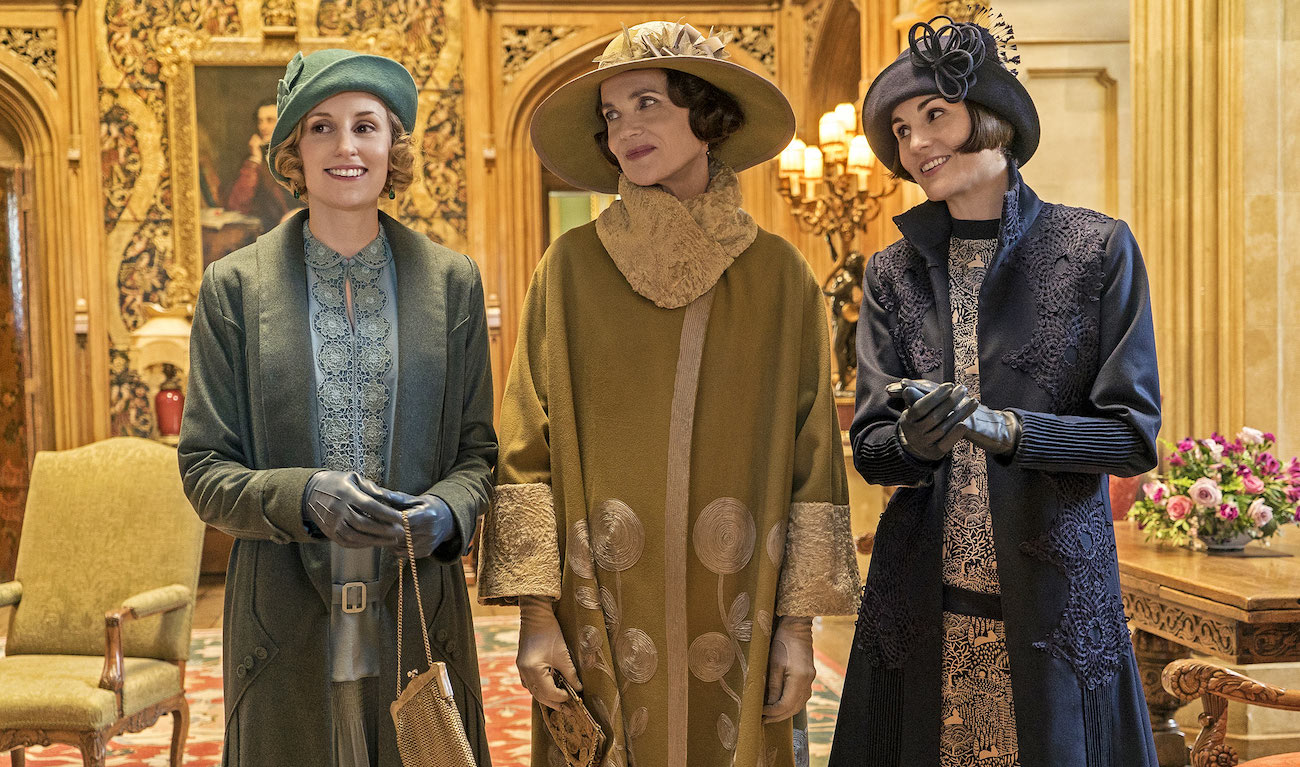Like many diehard fans, I was beyond excited when I heard that Julian Fellowes’ popular British TV series Downton Abbey was following its six-season run with a full-length feature film. Taking place between 1912 and 1925, the television series had introduced us to the aristocratic Crawley family and their domestic servants who lived together in an incredibly grand Yorkshire home called Downton Abbey. Throughout the series, the Crawleys and their servants snaked their way through many of the big historical events of the early 20th century. As the film picks up the story in 1927, the Crawleys and their intrepid staff are preparing for one of the most important experiences of their lives: a royal visit from the King and Queen of England. This exciting experience will ultimately unleash scandal, romance, and intrigue that will leave the future of Downton hanging in the balance.
Among the joys in revisiting these beloved characters is seeing the amazing work of costume designer Anna Robbins (Emmy-nominated for her work on the series) which is even more spectacular on the big screen. This is a time just beyond the Gilded Age, entering the modern one, which is reflected in great detail in the costumes from Dowager Countess of Grantham Violet Crawley’s (Maggie Smith) pastel, formal Edwardian garb to the more flapper-friendly styles favored by Lady Mary and Lady Edith (Michelle Dockery and Laura Carmichael). For the latter pair, the silhouettes and color schemes reflect their outlook – Lady Mary in more angular blacks and whites for instance, and a beautiful gold flowing 1920s gown for Lady Edith, a gorgeous use of fabric and pattern and color where you can really see the texture and detail. I loved sitting down for a chat with the talented Anna Robbins about her work on the film, even if I did feel painfully underdressed.
Danny Miller: I so loved being with these characters again. And as far as I’m concerned, your work is one of the most important stars of the film. It was already so gorgeous on the TV series but am I correct in noticing that it all seems ramped up a bit for the movie?
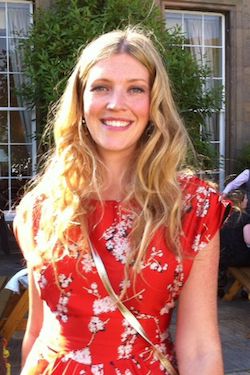
Anna Robbins
Anna Robbins: Oh, yes, it is definitely ratcheted up a notch! We set a high bar for the show, with all the departments really pushing to elevate everything, but I think watching it on television we all thought it could be even bigger. And then along comes the opportunity to make it literally bigger which was so much fun to do.
I know, I just wanted to stare at the threads on the fabric seeing all those beautiful clothes on the big screen.
Yes, which is exactly what made it so challenging since I people would be able to see the threads and the quality of the craftsmanship in such detail. I like to use as many originals as possible and those had to be of a very high quality to withstand that scrutiny.
Wow, how on earth do you find 90-year-old dresses that are in good enough shape to look new?
For women’s wear I’d say it’s about half and half. I use more originals in evening wear because those dresses were often carefully preserved and they weren’t the kind of things to be worn every day so they haven’t worn out. Some pieces do require restoration, of course, and if it can be done to a very high standard, we do it but sometimes the fabric is simply too fragile so I might be able to re-imagine it as something else or take the fabric and rework it somehow. It’s a combination of a lot of things, but yes, I really had to raise the bar for the film and make everything even more sumptuous.
And, of course, this film includes the royal visit, so I’m sure that storyline also ramped things up.
Yes, that definitely upped the ante but it also meant you weren’t going to be exploring the most up-to-the-minute risky trends in women’s wear because there’s a very specific elegance and classicism to how you would dress to meet a royal.
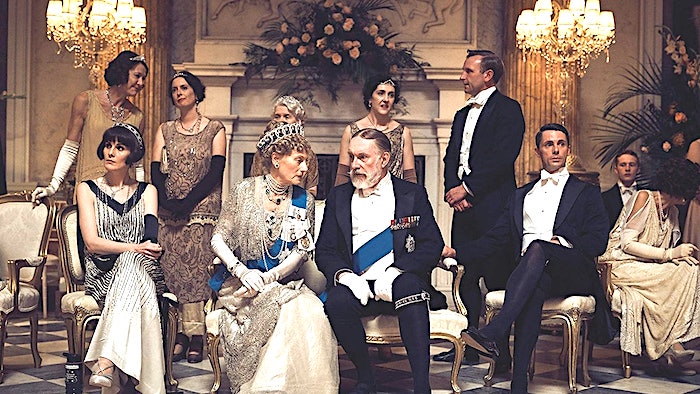
I would imagine that you get to know these characters better than almost anyone. Do you have to think beyond the script to the whole of their personal histories? For example, Cora (Elizabeth McGovern) having been raised in America, do you think that influences her clothes?
Oh yes, where they came from is very important. The wardrobe’s got to say as much about the past as it does about the present day. It’s a very intimate process as well, working with an actor to find that characterization and it becomes a very important tool for them. But I have gotten to know the characters really well which meant I had a shorthand when I went onto the film that allowed me to work at pace right from the beginning without needing to do the huge amount of research that I did when I first came on board.
Shorthand like you could see something and think, “Oh, Lady Mary would never wear that.”
Yes. At this point I can walk into a vintage shop and see a Lady Edith dress across the shop and know it’s going to work.
Lady Edith is someone who really interested me in this film because, as we know, she had a big change at the end of the series. It did seem like her new status was reflected in her clothes.
I think Edith had one of the biggest journeys of anyone throughout the series. I remember in Series 5 her wardrobe was very restrictive and pared back, very autumnal colors during the period when she was estranged from her daughter and just very low emotionally. Then in Series 6 she literally blossoms as a human and finds her identity and she’s suddenly in this literary world so I created this London working woman’s wardrobe which was very different from her estate wardrobe. It still felt like the same person but she was far more adventurous and bold in her choice of prints and color.
You can literally see her self-confidence change over the course of the series and it was amazing to watch how her physical appearance reflected that.
Yes, I loved dressing her. And now in the film it was important that we didn’t lose that sense of style she had found even though now she’s no longer a magazine editor in London, she’s the Marchioness of Hexham and outranks all of them. So we took everything that she’s learned about herself including her self-assuredness and sense of style and moved it up into the position that she’s in now. But still always focusing on the level of craftsmanship in the textiles, it might be embroidery, it might be devoré, it might be printed silk. There’s always some sort of interesting surface to the fabrics that I use for Edith.
Was there a touch of rubbing her new status in Mary’s face with her clothes at all? A bit of showing off?
I don’t think so because I don’t think Edith has an ego like that. And she and her husband are very modern in their approach to their high positions. Remember — they arrive at Downton without a nanny. They call themselves “modern folk.”
I guess just the fact that she’s happy now is enough for her to stick it to Mary.
(Laughs.) Yes, exactly. I love dressing the two of them in their scenes together. Even when they weren’t at each other’s throats, there’s always a contrast, I always look to create some kind of dichotomy between them. Their dresses should always work with each other but create a nice contrast. And, of course, as individuals they’re very different.
I know the film takes place in 1927, which is a few years after the series ended, but do you have to think about certain characters like Violet (Maggie Smith) who may hold on to past styles in some way?
Well, Violet is a Victorian/Edwardian lady and that will never change. But the fabric choices may change. Where she once wore a fabric with an Edwardian pattern, that may become more art deco. You’re always looking for different micro trends that affected clothing manufacture, the way they were put together. And her jewelry might go from being more square cuts to show more modernity. I like to find ways to show that sense of modernity without changing her very recognizable silhouette.
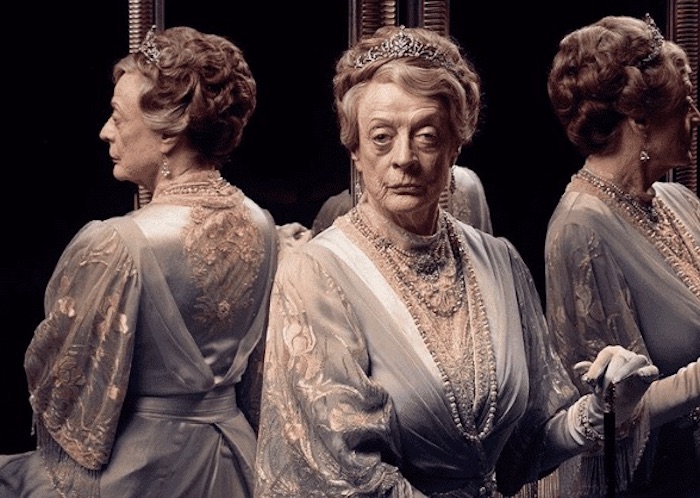
Dame Maggie Smith
Did you know that there was a movie coming as the series was ending? Were things saved in a different way than they might have been otherwise?
No, we didn’t know. We hoped, but nothing was certain back then. Luckily, the main jeweler I worked with wasn’t organized enough to disband the collection and use it in other things so it was mostly intact.
Plus, the series was so popular, you could take the whole collection on the road!
Yes, we did work on a touring Downton Exhibition over the years so we’ve always been aware that there’s a life for the costumes after filming whether or not they ended up in a new film. But really getting to create new costumes for these wonderful characters was just a hypothetical dream that has thankfully now come true.
We’re talking so much about the women and my first instinct is to assume that costuming the men isn’t as interesting, but then I see their gorgeous clothes on the big screen and I’m totally fascinated.
Oh God, I love working with the men, I love tailoring. If you get that right, everything just looks so good. And the fabrics are fantastic. I was talking about using original pieces with the women, but it’s very rare that you’ll find any originals that you can use with the men.
Because men back then wore their clothes so much more often and they just wore out?
Yes, exactly, they just haven’t lasted. But the bits we do find are wonderful references for the cut and shape and how the pieces are constructed. I also work to make sure the men’s clothes complement the women’s and that all the scenes work together in composition. But the detailing in the menswear is just wonderful. And if you look closely in the film, the men change as often as the women do. I think Robert changes four times on the day that the Kind and Queen come to Downton. I was even able to design new dress uniforms for the livery staff with the Crawley insignia in the fabric, it was wonderful, those beautiful green tailcoats with silver frogging and lacing with the white breaches and stockings. Just brilliant.
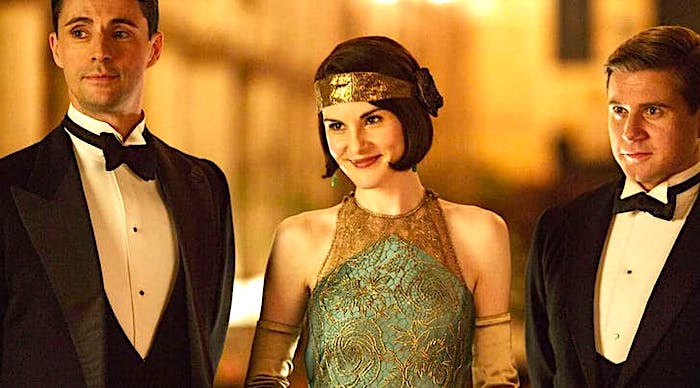
Matthew Goode, Michelle Dockery, Allen Leech
So incredible. And then you leave work and go out into London and see people dressed like I am right now — it must be so depressing!
(Laughs.) I mean, I’m sure it was very hot and uncomfortable at times, so it’s good that we’ve moved forward, but those clothes do look so fabulous and I’m glad I get to spend such a huge proportion of my life with them!
Is designing for the servants more of a case of strict research on what the staffs of big houses would be wearing in 1927?
Well, there is lots of research and looking at what would have been worn but then you design touches for each character. For example, there is always a sort of very subtle floral pattern within the silk for Anna. And it may be more geometric for Baxter, with a more complicated cutting technique since Baxter is a dressmaker.
Is the implication that the servants would be mending their own clothes?
Yes, to some extent, so you’re going to see differences. They’re all designed to the character and to make them identifiable even if there’s a common look.
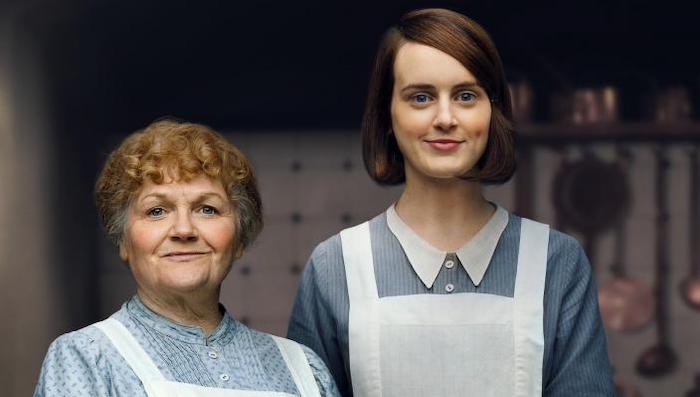
Lesley Nicol and Sophie McShera
I imagine at the first fittings for the film it must have been heavenly for the actors to slip back into these costumes to get back into character.
It was wonderful seeing them literally step back into their characters’ shoes. And it’s always been a very collaborative process working with them. It’s a joint effort to find the right looks. I lead it, for sure, since I have an overview of how the whole thing has to look and I know what’s going to work together in each scene such as they’ve got to start off in this setting which may be against red and then move into this room which might be green.
Oy, that seems like so much to keep track of. And it’s not like in real life we ever know the colors of every room we’re going to walk into!
Exactly, but I have to create these huge charts that allows me to painstakingly keep track of all those different elements. I work very closely with the director, production designer, the DP, and the actors. I have to think about lighting and how the colors are going to behave on camera.
I remember reading about the making of Gone With the Wind and how Selznick and costume designer Walter Plunkett tortured the actors with real corsets and other undergarments from the period even though they would never be seen. Are you a stickler period detail as well?
I am all about what makes the right silhouette but I might make the garments worn under the costumes more comfortable than the originals might have been. Remember, they didn’t have the luxury of stretch materials! Unless you actually see the underwear, as you do in some scenes in the film, then I absolutely insist on the real thing.
Of course, the 1920s were more kind to women than previous eras in terms of undergarments.
Absolutely. You had underwear then that created a more boyish silhouette which could still be confining for some. But I also find that actors are quite keen to use whatever underwear creates the foundation that makes the clothing look more authentic and therefore more believable. And sometimes the underclothes affect posture and even the way you speak. I think it’s worth noting that while the girls lost the corsets, the gents were still wearing stiff-collared shirts full of starch with starch-fronted shirts. These are very uncomfortable, and you shouldn’t even be able to get a finger down the collar. So, rest assured, I still put the actors through the ringer.
I used to love the original Upstairs, Downstairs before Downton Abbey and I remember the actors talking about how they tended to be treated differently on set depending on what class they were playing. I remember Jean Marsh, who played the parlourmaid Rose, once said to the people on set, “Hey, I created this series, why is everyone treating me like I’m not as good as Lady Marjorie?” Did you ever notice anything like that on your set?
Oh, that’s funny. No, I wouldn’t say so. We were really like one big family and very equal. I think sometimes the downstairs characters might get a bit of envy in terms of all the beautiful fabrics and costumes that the upstairs characters got to wear, but by the same token the upstairs characters had to do fittings week upon week upon week. The downstairs characters had a much easier time of it pre- and post-filming where they could just get into their cars and leave whereas I had to drag Lady Mary to do the fifth fitting that week for a new dress that she was wearing the following week.
I do feel inspired by your magnificent clothes in this film. As God is my witness, I want to start dressing better!
Go for it! The thing is, a bespoke suit can be very comfortable because it’s been made specifically for you. It molds to your body.
Thanks so much for chatting with me. I’m excited about all the Downton Abbey frenzy I’m seeing. This is definitely the movie that we need right now in this country, if you know what I mean.
Oh, trust me, we need it right now in the UK, too!

